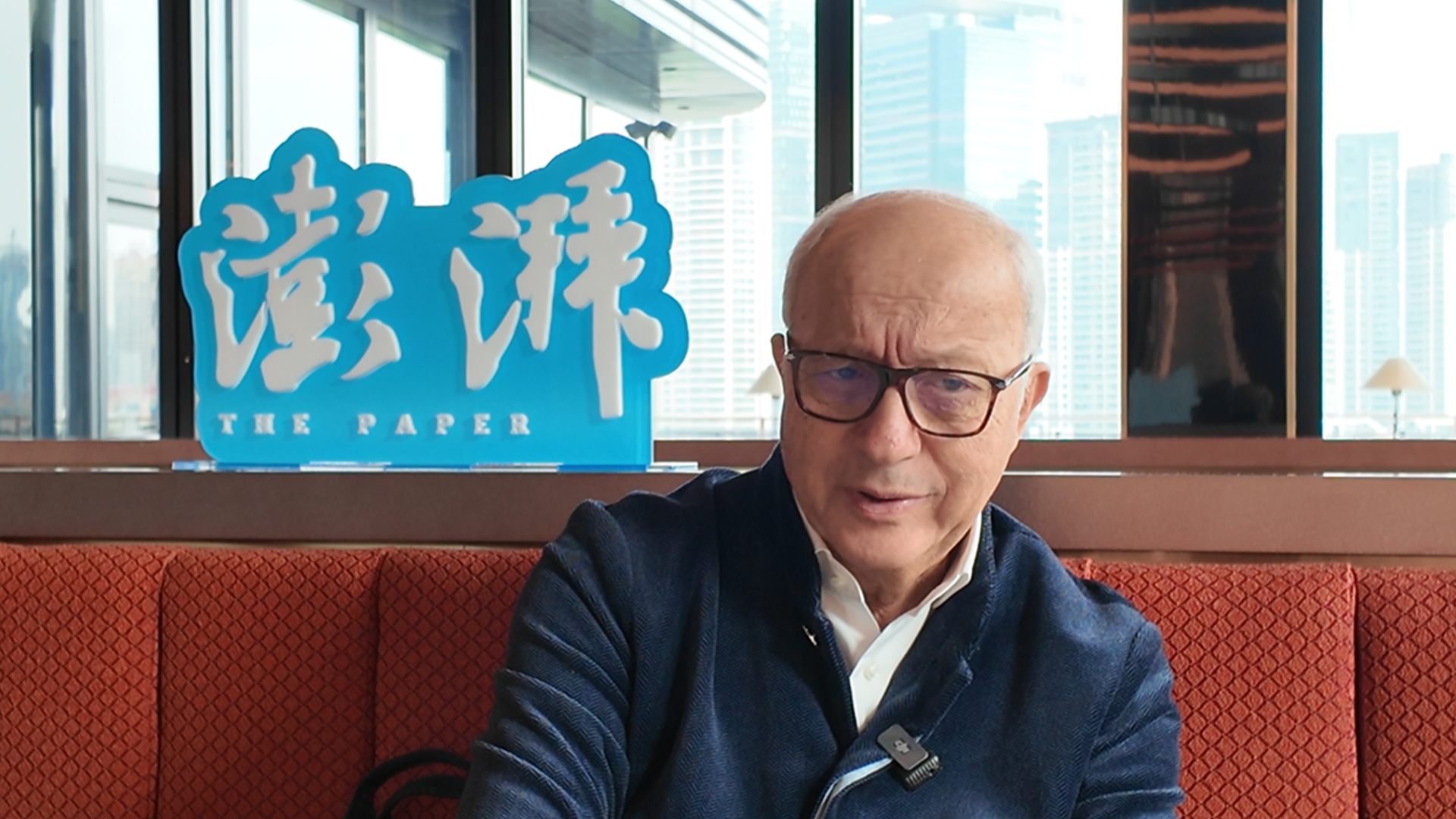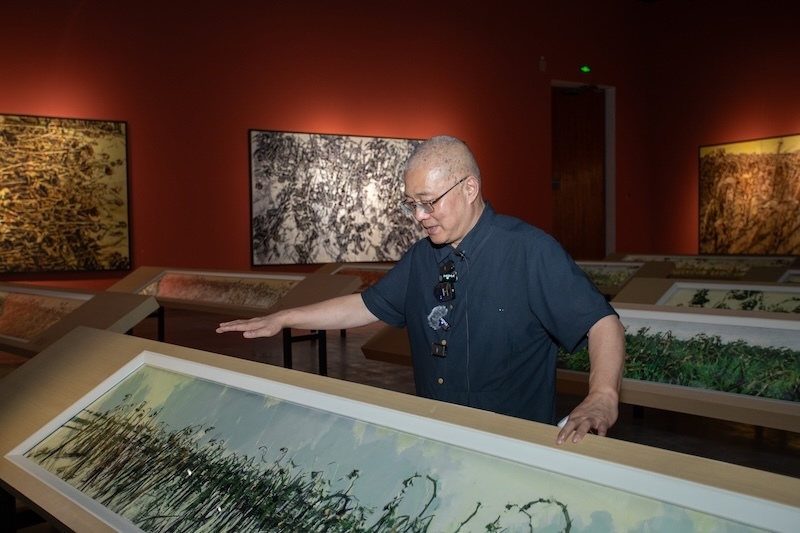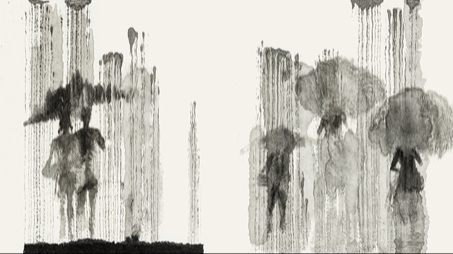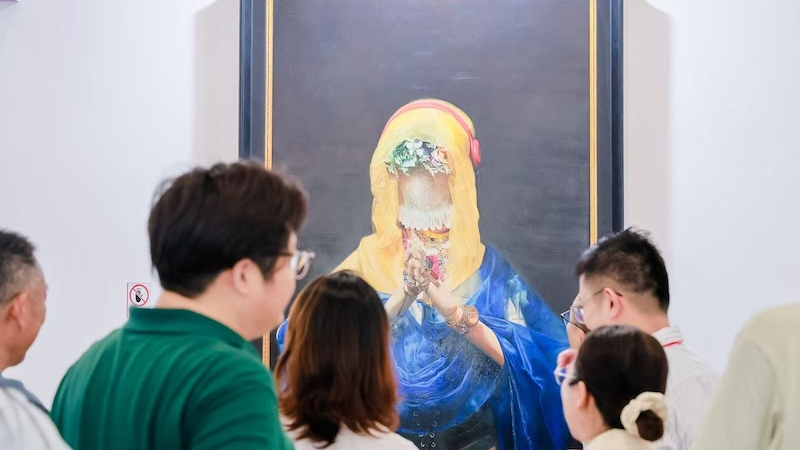
Laurent Fabius, a renowned French politician who has served as Prime Minister, Foreign Minister, and President of the Constitutional Council, has visited Shanghai numerous times. Recently, Fabius returned to Shanghai as a painter. After 15 years of painting in secret, he held his first solo art exhibition, "In Paradise," in Shanghai. On the occasion of the exhibition's opening, The Paper | Art Review interviewed Laurent Fabius.
"I have always loved art, especially Rodin and Zao Wou-Ki, but I didn't start painting until 15 years ago. Now, I need painting, just like a person needs exercise, food and drink. It can be said to be a necessity in life," said Laurent Fabius.

Stepping into the first-floor exhibition hall of the Shanghai Fosun Foundation, one encounters a series of abstract paintings, rich in color and texture, resembling the shadows of a forest, a crack, a glimmer of skylight, a patch of reeds... These abstract visual languages metaphorically represent civilization, nature, and humanity. This is Laurent Fabius's first global solo exhibition, "In Paradise."
Born in 1946, Laurent Fabius always looks cheerful and smiling. He served as Prime Minister of France from 1984 to 1986, becoming the youngest Prime Minister in French history at the age of 37. He later served as Minister of Foreign Affairs and President of the French Constitutional Council. In recent years, he has retired from all his positions to focus on painting, presenting himself to the public as an artist. He told The Paper | Art Review: "I've loved art since I was a child, and especially over the past 15 years, painting has been a part of my life. Without painting, I feel like something is missing."
Born into a family of antique dealers, Fabius was nurtured by art from a young age. Although his life trajectory shifted to public affairs and politics, art remained a constant companion. His inner passion for art blossomed under the guidance and inspiration of friends like artist Pierre Soulages and Chinese artist Zao Wou-Ki. Fifteen years ago, a set of painting tools gifted by his partner marked a turning point in Fabius's life. From that moment on, he began his transition from politician to artist, finding new avenues of expression on canvas and developing his intuitive, abstract style over the years.

Laurent Fabius
The exhibition, titled "In Paradise," opened to the public at the Fosun Foundation in Shanghai on October 15. Featuring more than 50 paintings by Fabius, including single and multi-panel paintings, it showcases his reflections on civilization, nature, and humanity, transformed into a visual pictorial language.
In Fabius's work, color is transformed into texture, rhythm, and language. Whether spraying, scraping, or layering paint, every brushstroke leaves a mark, and every layer of color unfolds a narrative. Unlike ordinary artists, Fabius's work is permeated by a long-standing concern for critical global issues: post-industrial civilization, ecological and environmental responsibility, the dilemma between institutions and ideals... Painting offers Fabius an alternative expression that transcends political discourse: directly touching upon emotions and memories through the language of color and texture. For Fabius, "nature" is a major theme in his work, a continuation of his role as President of the 21st United Nations Climate Change Conference (COP21) in 2015, which led to his promotion of the Paris Agreement.
On the occasion of the opening of the exhibition, The Paper interviewed Laurent Fabius, talking about the artistic influence he received since childhood, the impact of art on his life, and his understanding of art. "For me, the flow of emotions is crucial in artistic creation," Fabius said.
Dialogue|Laurent Fabius
The Paper: You chose Shanghai as your first solo exhibition, calling it a symbol of “building bridges, not erecting walls.” Apart from the invitation from Shanghai, were there any other reasons?
Laurent Fabius: For the past 15 years, I've been painting while also engaging in important official political work. However, I didn't want to conflate artistic creation with official duties. It wasn't until I stepped down from my last position as President of the French Constitutional Council that I truly began to devote myself to art. It was at this juncture that the Shanghai Fosun Foundation invited me to hold a solo exhibition. I felt very fortunate, as I have long been engaged in Sino-French relations and am deeply interested in Chinese culture. This exhibition marks my debut, and I will also hold an exhibition in France in 2026.
The Paper: In your opinion, what role can art play in communicating Chinese and French culture, especially in the current complex international environment, that cannot be replaced by traditional diplomacy?
Laurent Fabius: The current difficult international situation affects all of us, including China. I believe art plays a very important role in this. I paint abstract paintings, but they are not disconnected from the world. They contain many themes and content related to the world, such as the relationship with nature, which is a topic that I care deeply about. This is similar to the important role I played in the Paris Agreement.

"In Paradise" exhibition site
The Paper: In a video in the exhibition hall, you said, "Because of beauty, don't lose faith in humanity."
Laurent Fabius: Art itself does not serve a certain idea. I believe that art serves art itself. Art is fundamentally about beauty, and beauty can shape human society.
The Paper: This exhibition is called "In Paradise," and it concludes with the Chinese concept of "Peach Blossom Spring." How do you compare and contrast this concept with the "Garden of Eden" or "Utopia" of Western culture?
Laurent Fabius: The exhibition title was actually chosen by curator Shen Qilan after a work in the exhibition. It references Chinese culture and is appropriate. The world has different civilizations and philosophies, but all of them share a common quest for an idealized society.
This is also related to my official career. I often quote Jean Jaurès’s famous saying, “Pursue ideals, understand reality.” I think official functions and artistic careers may be different, but in fact these differences all involve the content of “pursuing ideals.”

Shanghai Fosun Foundation, “In Paradise” exhibition

Laurent Fabius, Urban Symphony, 2023
The Paper: You grew up in an artistic family with a love for "beautiful things" and antiques. Did this early environment influence your later artistic vision?
Laurent Fabius: First, you're right. Second, this isn't always a good thing. My father took my siblings and me to the museum every week. But I personally don't recommend this for parents, whether Chinese or French, because it's excessive and can sometimes lead to rebellion. Personally, it took me many years to return to art. I wouldn't expect that of my own children, and instead, I'd rather adopt a more down-to-earth approach to raising them.

Laurent Fabius, Extraordinary Garden, 2023
The Paper: You mentioned before that when you were young, you would get goosebumps or be moved by some touching works of art when you visited museums. Looking back now, which works have had the greatest impact on you?
Laurent Fabius: It's not a single work that suddenly captivated me, but rather a series of works, painters, or sculptors that led me to where I am today. I'm a huge fan of sculpture, especially sculptors like Rodin, whose work I'm familiar with. More recently, Giacometti's work has deeply moved me. In the field of painting, some relatively classic examples include the renowned Leonardo da Vinci and the Impressionists.
In the realm of modern and contemporary art, Zao Wou-Ki has had a profound influence on me. I even met and socialized with him in his later years. Of course, there are also American artists like Joan Mitchell, whose artistic style is quite different. To quote my friend, artist Yan Pei-Ming, "I admire all of these artists immensely."

The Paper: In the video in the exhibition hall, you talked about your friendship with Pierre Soulages and your creations, including his advice to you.
Laurent Fabius: Coincidentally, Soulages and I lived just a hundred meters apart in Paris, so we used to go to the market together on Saturdays and Sundays. His wife is still alive; she's 104. My partner and I were often invited to their home in Sète, near Montpellier in the south of France, and we became friends.
Pierre Soulages also provided me with advice on painting. While I didn't actually adopt the same subject matter (his paintings are known for their focus on black), he did teach me a lot, especially how to use a brush and create multiple layers. I loved watching him work in his studio in Sète, so he definitely influenced me both aesthetically and as a friend. Soulages and I also shared two common passions: painting and rugby. We used to talk a lot about painting and often watched rugby games together.

Pierre Soulages

Works by Pierre Soulages
The Paper: For Chinese audiences, what's most interesting is your mention of your love for Zao Wou-Ki. Could you please elaborate on this, including your interactions with him?
Laurent Fabius: I met Zao Wou-Ki in his later years, along with his wife, Madame Marquet. I deeply admire Zao Wou-Ki's work because it possesses a power and poetry that deeply moved me. I was impressed by his background in both Chinese and Western art. He is, of course, a great master, but what strikes me most about him is that his paintings, regardless of scale, convey a sense of the immensity of the canvas, a connection to the world beyond. To me, this is what great art is: both finite and infinite.

Zao Wou-Ki at work
The Paper: Throughout your long public career, artistic creation has always been your "secret." What ultimately motivated you to transform this private passion into a sustained, dedicated painting practice fifteen years ago?
Laurent Fabius: It was a necessary release. As I just said, artistic creation itself only began about fifteen years ago. I didn't start with paintings, but rather with assemblages. I bought some wood and small hand tools, the kind used by shoemakers and farmers. I nailed these tools to the wood, transforming them and giving them meaning. These assemblages, born from my imagination, were very interesting to some of my friends.
Later, by chance, my partner gave me a painting set for my birthday, which included an easel, canvas, brushes, and paints. That's when I started painting. That was fifteen years ago.
At first, my paintings were mediocre, so I destroyed them. Just like my good friend Soulages, he would destroy many of his unsatisfactory works. Then, slowly, I felt better and better, and painting became a true passion. Now, I need it, just as a person needs exercise, or food and drink—it's a necessity in life, you could say. But I kept my art private until after my career, when I finally released it publicly. This is my story with painting.

Details of Laurent Fabius's works

Details of Laurent Fabius's works
The Paper: In fact, the attitude of literati painters in Chinese history towards painting was mostly non-utilitarian. They regarded painting as a necessity of life, just like drinking tea. Without it, life would be missing a big part.
Laurent Fabius: This also reminds me of a difference. Education in the West, in France, is different from education in China. I'm not surprised that so many important figures in Chinese history were painters. But in France, education often focuses on literature, while painting is underdeveloped. You'll find that many important figures in France, such as politicians, write books because France has a literary tradition, but they don't paint or exhibit their paintings. So, the education is different.
The Paper: Because Chinese writing traditionally involved brushes, scholar-officials were required to master brush techniques, and a large portion of Chinese painting history was also created with brushes. Furthermore, you quoted the poet Rimbaud's famous line, "I am the Other." On canvas, what is the fundamental difference between Laurent Fabius as an artist and Laurent Fabius as a politician?
Laurent Fabius: Rimbaud was a great 19th-century poet who died young. If I remember correctly, the phrase "I am the other" was written in a letter to another poet in 1871. It later became very famous and has been analyzed by many psychologists and psychoanalysts.

"In Paradise" exhibition site
My interpretation of this statement is that a person's growth or the way they behave, with some unconscious elements, shapes their actual personality, which differs from what we perceive as their superficial personality. I personally consider myself very fortunate, possessing diverse tastes and work responsibilities, or perhaps even multiple personal identities. I consider myself the sum of all these identities: a politician, a father, and a painter. It's difficult to distinguish one from the other, but rather a whole.

Laurent Fabius at work

Laurent Fabius organizing his artwork
The Paper: You once brilliantly compared painters to the "freedom" of their creations, while public leaders are constantly under "negotiation" and "responsibility." Having experienced the absolute freedom of art, how do you view the years when you were constrained by political responsibility?
Laurent Fabius: The freedom of expression enjoyed by painters differs from that enjoyed by public leaders. Regarding the relationship between art and politics, I believe the degree of freedom varies. Politicians are often concerned with the overall public interest, which can lead to social constraints, such as budgetary and financial constraints, or even humanistic restrictions. But as a painter, you have complete freedom. You can paint however you want, and if you don't like it, you can destroy it. There's indeed a huge difference in freedom.
But there are also commonalities between politics and art. This commonality can be hypothesized. In a political career, a person may become a mayor, a minister, or a president. If you engage in art, you may become a painter or a novelist. The common point between the two is the pursuit of idealism.

Laurent Fabius in politics

Laurent Fabius in politics
The Paper: Is there any influence between your promotion of the Paris Climate Agreement and your artistic creation?
Laurent Fabius: Yes. However, if the Paris Climate Agreement is to be successfully reached, it would require 195 other countries to accept it simultaneously. But it would be much easier if we could draw a picture.
The Paper: So being a politician is even more difficult.
Laurent Fabius: Yes.
The Paper: Could you please tell us about your usual creative state in France?
Laurent Fabius: I prefer to work in the mornings. I used to have a small studio in Paris, but I could only produce small pieces. Later, I moved to Toulouse in the south of France and acquired a larger studio space, which allowed me to create larger works. I can work on the floor or on a table. Sometimes, I'll leave a piece alone after it's finished, returning to it a week later to continue. Finally, I apply a varnish to the finished piece to set it in place, and sometimes I frame it. It's physically demanding and time-consuming, but I enjoy it.

Laurent Fabius working in the garden

Laurent Fabius in the garden
The Paper: Do you have an art collection yourself? Could you please share some of your pieces?
Laurent Fabius: I also collect art. I own several sculptures from the 19th century and several paintings, both 19th-century and contemporary. However, since walls aren't infinitely large, as my paintings have grown and taken up more space, my collection has dwindled. Especially in modern homes, where walls are limited in size, I can only collect works of limited size. My personal collection is quite limited. However, I love museums and galleries, and on the art market, I often discover works by lesser-known artists that really interest me.

Laurent Fabius delivers a speech at the opening ceremony of "In Paradise" in Shanghai
The Paper: Do you have any knowledge of classical or contemporary Chinese art? Will you hold a joint exhibition with Chinese artists in the future?
Laurent Fabius: If I have the opportunity, I hope to hold a joint exhibition with Chinese artists. My first exhibition is in Shanghai, which is a very positive sign. I am very happy to know that you like the works in the exhibition hall.
The exhibition will run until October 30
(Kung Xianhe also contributed to this conversation)


